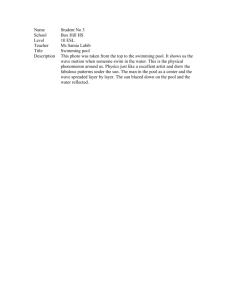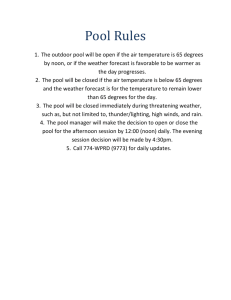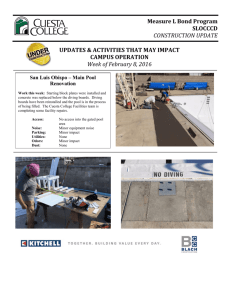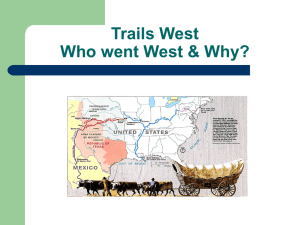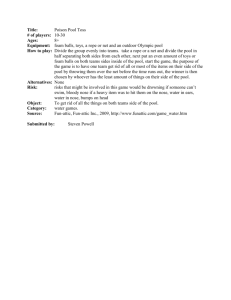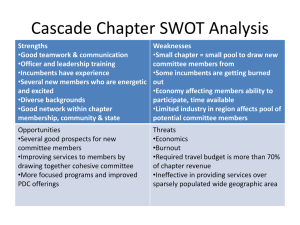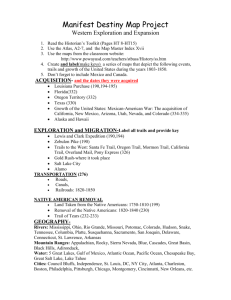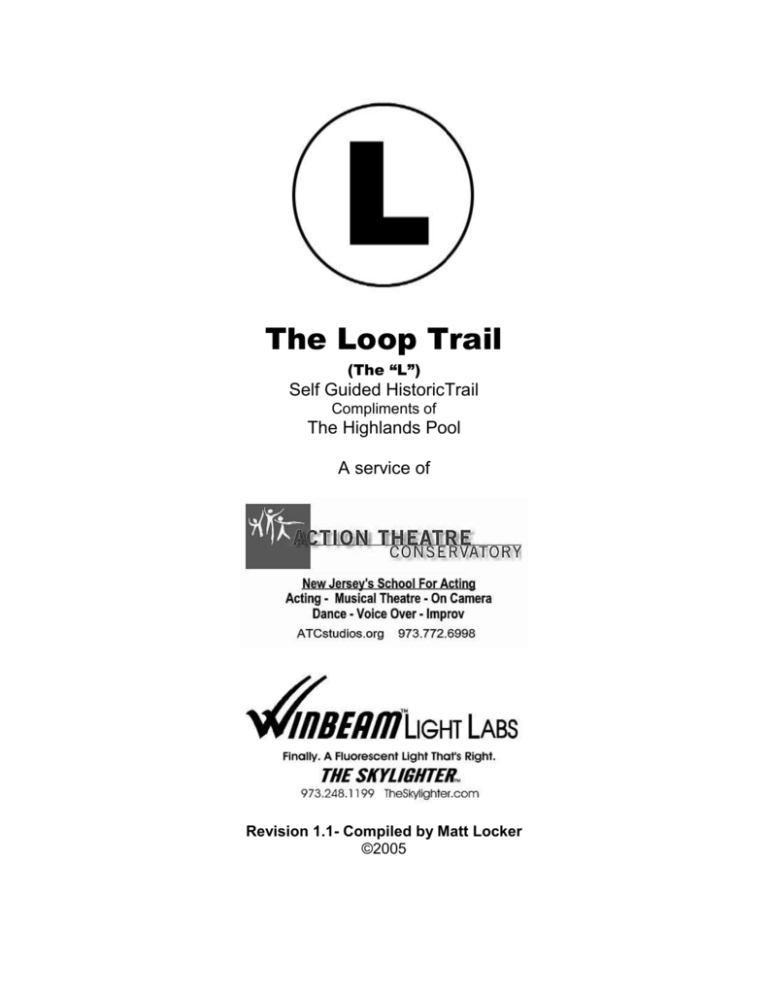
The Loop Trail
(The “L”)
Self Guided HistoricTrail
Compliments of
The Highlands Pool
A service of
Revision 1.1- Compiled by Matt Locker
©2005
(2)
The “L”, or The Loop is a short trail that circles the Highlands pool, providing a bit of
history and access to the main hiking trails. If you are at the pool for several hours, the
“L” makes for a nice walk between swims. The walk can be done in about 20 minutes.
Exiting from the pool’s main gate, turn right and follow the “L” blazes. They will lead
you alongside the blue mine brook. The blue mine brook cuts across Weis, cascades
down the Wyanokie falls, passes Blue Mine, and empties into the Wanaque Reservoir.
Continue along the bank of the brook and you will come upon a small brick pump house,
used to deliver underground spring water to the pool in the event of a drought.
Mounted on the front of the pump house are two memorial plaques. One is for Beverly
Adam who lived from 1939-1959…and the fountains were dedicated to her in 1960.
Fred Salvini’s life was from 1898-1977.
The surrounding area is the Weis Ecology Center. Weis operates independently of the
Highlands Pool. Information on Weis can be obtained at their visitor center which is
found at the end of the gravel road.
After the pump house, make a right across the bridge towards the parking lot and another
quick right. You’ll now walk upstream alongside the brook for a short stretch, then make
a left at the chain link fence. At the top of the hill, make a right as per the “L” markers.
This stretch of The “L” is a restored section of the lost “Melody Trail”, which faded away
in the early 1980’s. It was marked with green musical notes on white ovals. It’s course
was from the concrete ping pong tables (by the inner parking lot) at Weis, along this
southern half of the “L”, then upstream to Winfield Farm. The latter segment has been
preserved, but re-named the “W” (Weis-Winfield). You will cross the “W” shortly.
The vista on your right is the Highlands Natural Pool. It’s a chemical-free spring fed pool
built in 1935.
Prior to the building of the pool, The Nature Friends was started May 20, 1920 by a
workers’ organization with the purchase of the Carrigan ( Snake ) farm. The camp grew
from 11 acres to 170. A brick dormitory, built in 1932, still stands and serves as the office
headquarters for Weis.
In 1940 the Winfield Farm was added to the property to protect the pool’s water supply..
The American Ethical Union bought the camp in 1968 as a conference center. About 50
cabins were erected throughout the grounds, and many more on surrounding property.
Many of the cabins privately built on outside the camp were expanded into the homes
seen today along Snake Den Road.
(3)
The social center of the camp was Carrigan Barn, which housed the office, dining room,
social hall, and canteen. The Barn burned down in 1965, leaving only the concrete floor,
which was used for many years for weekly evenings of folk dancing.
So, why the pool? At the time, these woods were saturated with hiking trails, a primary
reason people visited and/or resided in the area. After a day of hiking in the hot weather,
a swim in the brook was customary. However, the brook usually dried up by mid to late
summer, so in 1935 a pool was built to capture the water.
In 1974 the grounds became known as The Weis Ecology Center, which kept the pool
operating until 1994. Also in ’94 Weis became one of NJ Audubon Society Centers.
The pool remained closed until area residents formed the Community Association of The
Highlands in 95, and the pool re-opened in 1996 by the association. It was two years
later when the pool officially became an independent entity and operates today (2005) as
The Highlands Natural Pool.
During the course of time from the first blazings, many of the trails fell victim to
development. Reprints of early maps from 1944 and 1966 showing the extinct trails are
available by special order. Please see last page of this guide for ordering information.
Continue along the “L”, making a left up a hill.
Near the top of the incline sits Weeping Rock. When water is present the rock appears to
weep. Not terribly historical, just another exhibit in nature’s art gallery.
Notice the directional arrow on a nearby tree marked “swimming”. It is a reproduction of
the original metal arrow mileage and directional signs painted by Nature Friends
Chairman Hans Wittich. Wittich also revised the color marking system in 1942.
The top of the incline brings us to the edge of Snake Den Road, make a sharp right just
before the pavement, and stay off the road by making a left along the “L” markers.
The Weir (on your right) was engineered as an upstream device for the pool. It serves to
direct water either to or around the pool, and to filter silt, leaves, and debris. The angles
of the wall were designed to create an eddy, slowing the incoming water thus dropping
the silt. The water temperature of the pool can be manipulated by the flow control
afforded by this structure. It also serves as a water reserve for fire fighters.
WARNING: Beneath the water level are powerful suction points.
When activated they are capable of pulling and holding a pet or a person
underwater. Please stay clear
(4)
.
The “L” continues along the southern bank of the stream. This portion of the stream is
used as an educational field trip which exposes nature to students from around the region.
ASIDE: This is the most-downstream part of the brook that rarely dries up completely.
Even in the driest weather, a small trickle of water can be found, a welcome relief to the
crawfish who live in these upper waters.
Intersect with the “W” (formerly the “Melody Trail”), and the Otter Hole Trail (Green
rectangle)
(W) Going left on the “W” will bring you to Winfield Farm. The barn, although
abandoned, stood until the late 1970’s. Lady Longfellow VIII, No. 51368 , a winning race
horse was housed there. She pulled first place on March 28, 1899. Winfield Farm was
purchased in 1940 to protect the water supply to the pool.
At the former farm, nature has reclaimed the open farmland with young trees, the
structures are gone, but the foundations can still be found. Remains of an old car sit on
the back of the property.
(OH) This new segment of the Otter Hole Trail was blazed in 2005, replacing the old
course along Snake Den Road. Turning left will lead to the head of the MINE
TRAIL(yellow on white) and HEWITT BUTLER TRAILS (Blue rectangle). The HB trail
leads to the Red-on-White blazes. Making a left on the reds will bring you to the top of
Wyonokie High Point.
(OH) At the BLUE and YELLOW trails head, you can also turn right and follow the
OTTER HOLE TRAIL (green) through Winfield Farm and on to Otter Hole.
You are now at the juncture of the “L”, “W”, and “OH” trails—all three will bring you to
the pool entrance. After the bridge, the OH (Green) follows the “W” to the right, the “L”
makes a quick left up a short hill. This short piece of trail was once part of the hike
leading to Pine Paddies and Wolf Den.
Wolf Den once stood on the northern end of Saddle mountain, which became a quarry
and no longer exists. It was, however the site where a Mr. Shippee killed the area’s last
she-wolf and her two young in 1819.
PLEASE DO NOT ATTEMPT TO FOLLOW THE OLD TRAIL. It is closed, the sights
are gone, and the property owners are very strict about trespassing.
Follow the “L” and make a hard right to a hilltop.
(5)
Swimming was not an option during the winter – so they turned to skating and skiing.
You are standing atop of the camp’s “home made” ski slope. At the time, the trees down
the center did not exist, thus the slope was wider than it appears today. These folks were
no strangers to innovation. They made their own ski lift by parking a car atop this hill.
On blocks, a rear tire was replaced with a wheel that pulled a rope loop up the hill. Guide
wheels were placed in the trees for support. On would grab the rope and be pulled to the
top of the hill. The ski lift was in operation in the 1940’s, by the mid 50’s it became a
sledding favorite for neighborhood kids. The remains of the car sat on this spot through
the 1970’s. Upon close inspection of the area, one might still find small glass fragments
from the windshield.
Follow the “L” down the slope to about the halfway point. About 100 feet to the right is
the stream fed from the “pool bypass” gate at the weir. Beyond the stream is a rock ledge
Bearing the memorial marker of Emil Plarre (1871-1941). Plarre was an enthusiastic trail
builder and tender. Many of his markers, a metal rectangle with embossed letters might
still be found in the deep woods. Plarre’s ashes were spread on the rocky ledge above the
pool. The Emil Plarre Falls stand between your current location and the site of his ashes.
Plarre’s wife had maintained a flower garden by his memorial marker. After her death,
the site became overgrown and was forgotten until 2005, when the Highlands Natural
Pool planned restoration.
Continue downhill and rejoin the “W”and “OH”, make a right and return to your starting
point.
End of THE LOOP. Note: The OTTERHOLE (Green) blazes continue outward to the
Weis outer parking lot. If you walk to the far end of the lot towards Ellen Street, you will
come to the Trail Head marking the other end of the MINE TRAIL (yellow on white) and
the WYANOKIE CIRCULAR (red on white). These are trails for another guide.
(6)
BIBLIOGRAPHY
New York Walk Book- Torrey, Place and Dickenson 1934
Windbeam – Minnie May Monks 1930
A Forgotten General – A.H. Heusser 1928
Bloomingdale Volunteers, W.P.A.
New Jersey Guide W.P.A. 1939
Iron Mines and Mining In New Jersey – W.S. Bagley 1910
Early Forges and Furnaces – Chas. S. Boyer 1931
Fritz Kirchner
Susan Reich
The Locker Family Archives
“The Loop”(the “L”) is an independent project and is not affiliated with the NY/NJ Trail conference. The
“L” has been constructed with the permission of The Highlands Natural Pool, who assumes no liability for
the accuracy of the information provided. As with all hiking, you assume all risk and liability if any injury
should occur. Project sponsors are held harmless against any claims of any type whatsoever.
(7)
HISTORIC ITEMS AVAILABLE FOR PURCHASE:
Reprints of (Norvin Area)
TRAIL MAPS FROM 1944 and 1966.
Sepia Tone. A record of the vast web of early area trails.
Prints: $55.00 each + tax and 5.00 S&H.
Reproduction of the
AMERICAN ETHICAL UNION CONFERENCE CENTER TRAIL
GUIDE
-Not dated, circa 1970
-Includes history of the area, and detailed descriptions of the hiking trails at the time of
printing.
-Places lost under the Wanaque reservoir.
-Glossary of Indian names found throughout the area.
-Short bios of trailblazers and pioneers.
-17 pages – typed on an 8x10 paper format, stapled.
Reproduction: 25.00 each+ tax and 5.00 S&H
A portion of the proceeds benefit The Highlands Pool
Credit Card and Money Orders accepted.
Call Winbeam Light Labs
973-248-1199
winbeamlightlabs@aol.com
Winbeam Light Labs, LLC is proud to preserve and pass along
local history.
Winbeam Light Labs is a protected trademark, all rights reserved.
Still think fluorescent light is ugly? Think again.
We fixed that problem.
www.TheSkylighter.com

